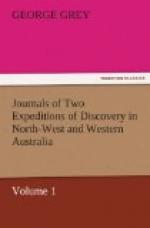(Footnote. A similar mass of shells, though of smaller dimensions, is spoken of by Captain King, at Port Essington: A curious mound, constructed entirely of shells, rudely heaped together, measuring thirty feet in diameter, and fourteen feet high, was also noticed near the beach, and was supposed to be a burying-place of the Indians. King’s Australia volume 1 page 87.)
For some days after our return from this excursion all hands were occupied in drying the stores, which had suffered a little from the late rains; in planting barley and potatoes; and in a variety of occupations of the same nature.
Excursion to country about Prince regent’s river.
As all the necessary magnetic and astronomical observations were now completed I seized the opportunity offered by the first favourable day and started with a party of three in the direction of Prince Regent’s River.
We made the river about Halfway Bay, and then followed its course, keeping about a mile or two inland. A considerable portion of the land in the neighbourhood of the river was most excellent, consisting of rich meadow plains. The general proportion of good country compared with the bad was still however but small.
Gouty-stemmed trees.
There was a very remarkable feature in the appearance of this part of the country, caused by the number of gouty stemmed trees (a species of Capparis ?) These trees grow to a considerable height, and had the appearance of suffering from some disease, but, from the circumstance of all of them being affected in the same way, this was undoubtedly their natural state. I measured one of the largest I here saw, and found that at eighteen inches above the ground its circumference was about twenty-eight feet six inches.
The foliage of this tree was slight but graceful, and it was loaded with a fruit of an elliptical form, as large as a coconut. This fruit was enclosed in a rind, closely resembling that of the almond, and inside the rind was a shell containing a soft white pulp, in which were placed a species of almond, very palatable to the taste, and arranged in this pulp much in the manner in which the seeds are placed in the pomegranate. Upon the bark of these trees being cut they yielded in small quantities a nutritious white gum, which both in taste and appearance resembles macaroni; and upon this bark being soaked in hot water an agreeable mucilaginous drink was produced.
This tree is, from this combination of useful qualities, a vegetable production of no slight value, and probably comes near the cocoa-nut tree in value. Its worth is well known to the natives for its vicinity is one of their favourite haunts. Around nearly all of them I have found marks of their fires, and on many of these trees were several successive rows of notches, formed in this manner:
All but the last row being invariably scratched out. These rows of notches were evidently of different ages, and I imagine must indicate the number of nuts taken each year from the tree.* I often also found rude drawings scratched upon the trees, but none of these sketches indicated anything but a very ordinary degree of talent, even for a savage: some were so imperfect that it was impossible to tell what they were meant to represent.




